 Case Report
Case Report
Application of Y- STR Typing in Solving a Forensic Case
Amany A AbdulhakimMoussa1, Mohammed A Al Ramadi1, Adel MA Elberry1 and Fadwa A Elroby2*
1Egyptian Forensic Medicolegal Authority, Egypt
2Department of Forensic Medicine and Clinical Toxicology, Beni Suef University, Egypt
Fadwa A Elroby, Department of Forensic Medicine and Clinical Toxicology, Beni Suef University, Egypt.
Received Date: December 05, 2019; Published Date: January 29, 2020
Abstract
Background:b> In sexual-assault cases, it was found that autosomal the analysis of DNA of gynecological swabs is a challenge, because if we find a large quantity of female material it may prevent detection of the male DNA. The solution to this problem was doing differential DNA extraction. The use of Y-chromosome genetic markers, such as short tandem repeats (STRs), helps the amplification of low quantities of male DNA independently of the victim’s DNA background.
Results: In the present case a young male was found dead under the balcony of newly married wife there were a suspect of illegal relationship, the use of Y- STR used to solve this case.
Conclusion: Y-STR is very useful in solving the cases of sexual assault with a small amount of male DNA.
Keywords: DNA; STR; Fall; Fracture; Skull
Introduction
The story begins with the report to find a dead young man in the third decade fell out of a balcony of a house and his family accusation was that a man had been killed, and he had a dishonest relationship with the murderer `s wife. The corpse was transferred to the morgue of the Egyptian Forensic Medicine Department for an autopsy to determine the cause of the real death. In viewing of the dead body, there is a young male wearing a gray jacket and a black T-shirt with blue jeans in his belt (Figure 1). The buttons of the trousers were open, which meant that he was in a hurry (Figure 2) and his underwear had a suspicious seminal material (Figure 3), there was blood comes from both the ears, and the nose of the corpse. Plain x- ray revealed depressed fracture at the left temporal bone of the skull, and pelvis fracture. The autopsy of the corpse showed that the stomach was full of food that has not yet been digested in addition to fractures in both skull with the presence of extradural hemorrhage (depressed fracture) and in the pelvis (Figures 2 & 3).
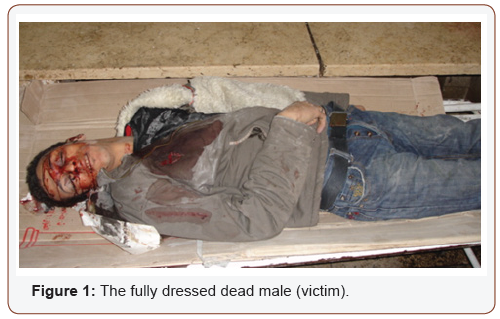

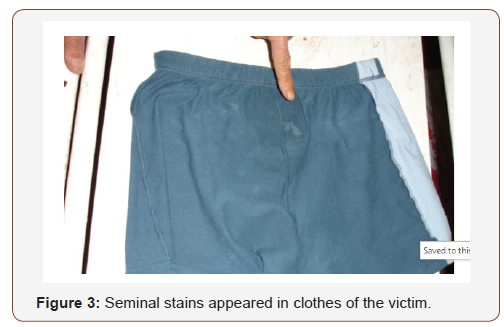
Blood samples were taken as well as samples of the urine from the bladder to search for the presence of any drugs and sent them to forensic laboratories for routine analysis with his clothes for DNA analysis .As well as the examination of the wife, control blood samples was taken from her and vaginal swabs to know whether contains the sperms belonging to whom (the husband or the dead young man) and blood samples of the husband accused taken for DNA analysis.
Material and Methods
The first step in semen investigation, usually focus on careful examination of clothing. Common methods are visual (examination of items for stains), fluorescence (the use of ultraviolet light to discover the fluorescent properties of semen), chemical (detection of acid phosphatase) and the second step, when the spermatozoa are located through a microscopic examination, that appeared with examination of clothes of the victim, also the vaginal swabs taken from the newly married wife [1]. Sperm heads were confirmed microscopically by hematoxylin and eosin staining. Sperm in a 0.5-cm piece of gauze was removed with 20 mL of distilled water. The resulting solution was immobilized on a glass slide, and then subjected to hematoxylin and eosin staining [2]. All the preliminary and confirmatory tests for presence of sperms in clothes of the dead body and the vaginal swabs from the recently married lady are positive results.
DNA Extraction
An area of 0.5 cm2 was cut out from the underwear of the victim “semen-stained site”. We did DNA extracted by using the EZ1 DNA Investigator Kit (Qiagen), following the manufacturer’s instructions for extracting DNA from body fluid stains. then we elute extracted DNA into 50. ml sterile deionized water. DNA was also extracted from the vaginal swabs by using the EZ1 DNA Investigator Kit following the manufacturer’s instructions for extracting DNA from vaginal swabs, and the extracted DNA being eluted into 100 ml sterile deionized water [3]. also, the extraction of DNA from all collected blood samples with QI Aamp DNA Mini kit [4].
DNA quantitation
DNA samples were quantified by the usage of Quantifiler1 Human DNA Quantification Kit (Applied Biosystems) with the ABI PRISM1 7000 Sequence Detection System (Applied Biosystems), following the manufacturer’s instructions [5].
STR amplification and typing
Using an AmpFlSTR® Identifiler® plus PCR Amplification Kit (Applied Biosystems®). an AmpFlSTR® Yfiler® PCR Amplification Kit (we separate Applied Biosystems ®) Amplicons using a genetic analyzer (ABI 3100; Applied Biosystems) then analyse it with the suitable software (GeneMapperID, version 3.2; Applied Biosystems) using standard procedures.
Results
Table 1 shows Y-filer of the DNA present in vaginal swabs of the recently married lady. And Table 2 shows Y filer of the husband while Table 3 shows Y filer of the victim.
Table 1: Y-filer of the DNA present in vaginal swabs of the recently married lady.

Table 2: Y filer of the husband.
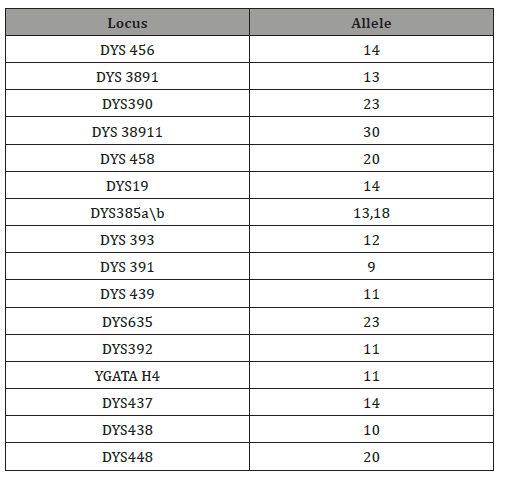
Table 3: Y filer of the victim.
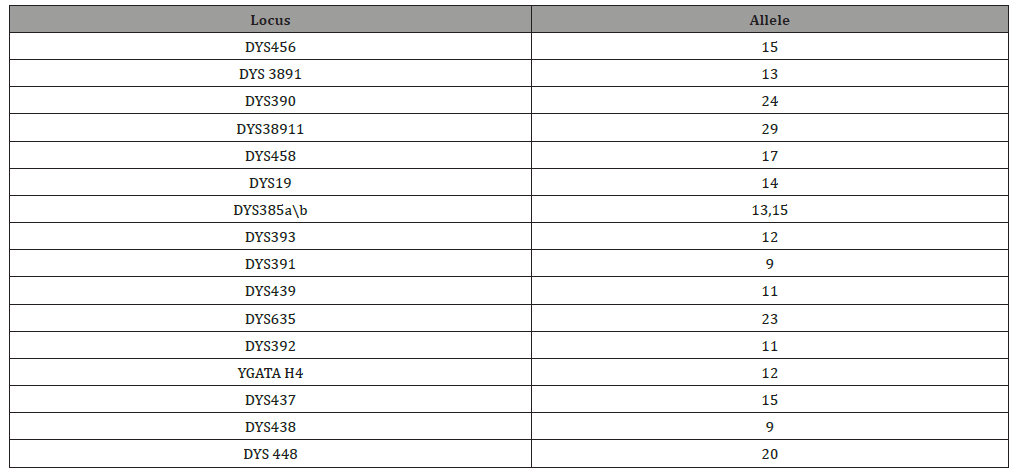
Table 4: The Identifier STR profiles of blood samples (victim and the husband) and of the semen in vaginal swab (from the recently married lady).

Table 4 shows The Identifier STR profiles of blood samples (victim and the husband) and of the semen in vaginal swab (from the recently married lady).
Results of the toxicological laboratory shows: Blood samples tested in forensic toxicology labs revealed, detection of delta 9-tetrahydrocannabinol (THC)in blood samples of both the victim and of the recently married lady, meaning that the victim and the young lady are smoking cannabis immediately before the death of the victim [6]. Positive result of presence of THC in urine of the victim indicates that he has been using cannabis long time ago [7,8].
Summary of the Case

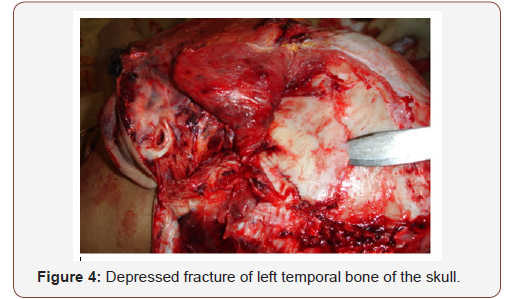
The victim was in illegal relationship with the recently married young lady before and after her marriage. On the day of the incident, when the victim with the lady, they smoked together cannabis in cigarettes, after having a full sexual relationship, her husband come suddenly to his home discovering the betrayal of his wife .The victim run to the balcony (at the third floor of the house about 8.40 m in height) away about 3.20 m from a tree to throw himself to catch this tree (7.20 m height), but because of his hurry he forgot to close his trousers and could not catch the tree ,he fell down(plump) to the ground of the street. As the result of his plump, he died because of extradural hemorrhage at the left temporal bone in addition to broken his pelvis .From the interpretation of all DNA profiles of all samples, revealed that the seminal materials which found in the vaginal swabs of the recently married young lady were belonged to the victim`s DNA not of her husband. So, the husband was innocent from killing the young victim (Figures 4 & 5).
Discussion
In forensic genetics, applications Y-STRs are useful for discrimination of paternal lineages rather than for individual identification. The male-specific part of the human Y chromosome is widely used in forensic DNA analysis, particularly in cases where standard autosomal DNA profiling is not informative. A Y-chromosomal gene fragment is applied for inferring the biological sex of a crime scene trace donor, especially suitable when males and females have contributed to the same trace, such as in sexual assault cases [9]. M. Hara, et al. 2013 revealed that, the discrimination of semen, short tandem repeat (STR) typing, and Y chromosome specific-STR (Y-STR) typing on five in semen stain that age 30–50-year-old stains. They observed sperm heads in all samples microscopically [10,11].
Conclusion
DNA Profiling has revolutionized forensic genetics and is widely accepted in medico-legal cases. DNA analysis provides the best avenue for unequivocal exclusion of the innocent suspects. Due to all these impressive applications, DNA test has become the darling of the criminal and civil justice system world over.
Abbreviation
Not applicable.
Acknowledgement
None.
Conflict of Interest
The authors declare that they have no conflict of interest.
References
- Saferstein R (2001) Forensic characterization of semen, In: Criminalistics, An Introduction to Forensic Science. pp. 342-352.
- M Hara, H Nakanishi, S Takahashi, A Kido, K Saito, et al. (2013) STR and Y-STR genotyping of 30–50-year-old semen stains. Forensic Science International: Genetics Supplement Series 4: e99–e100.
- Edwards A, Civitello A, Hammond HA, Caskey CT (1991) DNA typing and genetic mapping with trimeric and tetrameric tandem repeats. Am J Hum Genet 49: 746-756.
- (2001) QUIAamp DNA Mini Kit and QUIAamp DNA Blood Mini Kit Handbook, Quiagen.
- (2001) Amp FlSTR Identifiler PCR amplification kit. User ’s manual. PE Biosystems.
- Grotenhermen F (2003) Pharmacokinetics and pharmacodynamics of cannabinoids. Clin Pharmacokinet 42(4): 327-360.
- Huestis MA, Mitchell JM, Cone EJ (1996) Urinary excretion profiles of 11-nor-9-carboxy-delta 9-tetrahydrocannabinol in humans after single smoked doses of marijuana. J Anal Toxicol 20(6): 441-452.
- Results from the 2007 National Survey on Drug Use and Health: National Findings. Rockville, MD: Office of Applied studies, DHHS; 2007.
- Kayser M (2017) Forensic use of Y-chromosome DNA: a general overview. Hum Genet 136(5): 621-635.
- Cerri N, Ricci U, Sani F, Verzeletti A, De Ferrari F (2003) Mixed stains from sexual assault cases: autosomal or Y-chromosome short tandem repeats? Croat Med J 44(3): 289-292.
- National Forensic Science Technology Center. The evaluation of eight commercially available STR kits.
-
Amany A AbdulhakimMoussa, Mohammed A Al Ramadi, Adel MA Elberry, Fadwa A Elroby. Application of Y- STR Typing in Solving a Forensic Case. Glob J of Forensic Sci & Med 2(1): 2020. GJFSM.MS.ID.000530.
-
DNA, STR, Fall, Fracture, Skull, Death, Pelvis fracture, Blood samples, Victim, Forensic genetics, Criminal, Civil justice.
-

This work is licensed under a Creative Commons Attribution-NonCommercial 4.0 International License.






